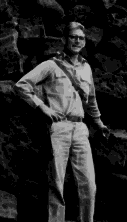KENNETH PIKE EMORY
1898 to 1992
This issue of AAOK is dedicated to the memory of the late Dr. Kenneth Pike Emory, Dean of Hawaiian Archaeology and Ethnology. Dr. Emory's name was synonymous with the Bernice P. Bishop Museum. It was through his efforts that the Bishop Museum shifted its anthropological focus on ethnology and ethnography to programs of archaeological investigation. The first archaeological excavations began in 1939, but work quickly ceased because of World War II. In 1950, excavations began again under Dr. Emory's supervision on O'ahu Island. The birth of Hawaiian archaeology officially took place in 1950. The first carbon-14 dates from those 1950 excavations spurred scientific investigation on Hawaiian and Oceanic prehistory.
Dr. Emory's knowledge of Polynesian ethnology, ethnography and mythology gave him a unique insight into prehistory. He firmly believed in the eastward movement of sea-voyaging cultures that populated the islands, and he dismissed the ideas of Heyerdahl and others as not being rational or substantiated in fact. Emory believed that glotto-chronology (the chronological history and relationship of languages) plus the facts of mythology, ethnology and ethnography with the advent of scientific investigations and radio-carbon dating techniques would inevitably prove him right. They did.
Dr. Emory was very much a renaissance man, well versed in literature, an experienced traveler, a musician, a natural athlete, and a naturalist. It is with such a person that this author was honored to be associated. He was my mentor and my teacher, and his ways have greatly influenced my own career and lifestyle. Now that he is gone to the Valhalla of archaeologists, I cherish his memory and similarly try to influence students the same way I was influenced.
